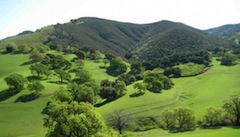Conservation leaders from Contra Costa County and many residents living in and around Dublin, CA recently celebrated their victory over the “New Farm” project and the withdrawal of the proposed 187-unit, 771-acre suburban development in the rural Tassajara Valley.

“This is a victory for everyone who loves the Bay Area and wants to see its farms, forests, and watersheds protected, ‘New Farm’ would have broken Urban Limit Lines put in place by an overwhelming majority of voters. For anyone who loves these lands, this news brings a sigh of relief,” explains Matt Vander Sluis, Senior Field Representative for Greenbelt Alliance.
Save Mount Diablo’s Land Programs Director Seth Adams agrees with Greenbelt Alliance. “This is our third victory defending the Urban Limit Line since 2010. Hopefully we’ve turned a corner. The Urban Limit Line is no longer threatened by this illegal project, and efforts to protect land in the Tassajara area south of Mount Diablo are expanding. The ‘New Farm’ project was out of touch and ultimately unsuccessful. It’s time to move forward, not backward,” said Adams.
Fake Farm, Real Threat
In 2007, developer consultant Tom Koch submitted the controversial “New Farm” project on behalf of his client Samir Kawar to the Contra Costa County Board of Supervisors, and the County agreed to begin a General Plan Amendment study. The 771-acre project was in reality a “fake farm” that would have included million-dollar estate houses, a large cemetery, and an olive orchard landscaping as window dressing to suggest compliance with the area’s agricultural zoning.
The project site lies entirely outside of Contra Costa County’s and the Town of Danville’s voter-approved urban limit lines, and outside of the City of San Ramon’s voter-approved urban growth boundary. Had the project been approved, it would have illegally broken these open space protections and brought urban development and urban municipal services outside the lines. It would have also violated Measure J-2004, Contra Costa County’s transportation sales tax, threatening to make the county ineligible to receive millions of dollars in transportation funds. In addition, residents would have been burdened with worsened traffic, strains on drinking water supplies, and a weakened agricultural economy.
Coalition Calls for Respect of Law and Voters
In response to the “New Farm” project, a coalition of concerned organizations and individuals formed to defend the voter-approved urban limit lines and keep the Tassajara Valley protected from destructive development. The coalition included residents from Danville and San Ramon, Greenbelt Alliance, Save Mount Diablo, Sierra Club, and the California Native Plant Society, among others.
Momentum built quickly. Data from a public polling firm demonstrated strong voter opposition to the project. A legal review conducted by Shute, Mihaly & Weinberger LLP confirmed that the project was “inconsistent with numerous provisions of the (Contra Costa County) General Plan, including provisions adopted by voter initiative.” News coverage and public presentations helped spread the word. Soon residents began sending postcards and emails urging rejection of the project.
Meanwhile, coalition members helped defeat two similar attacks on Contra Costa County’s Urban Limit Lines. In 2010, Tom Koch pursued Measure F to break Brentwood’s Urban Limit Line. Later that year, San Ramon proposed Measure W to break its own Urban Growth Boundary and open the Tassajara Valley for major development. Voters rejected both measures by large margins.
In late February 2013, five and a half years after it first submitted its application, the development company behind “New Farm” officially pulled the plug on the controversial project, submitting a new project for part of the same site to Contra Costa County for review.
New Proposal, Same Cow Dung
The new proposal, dubbed “Tassajara Parks,” requests that the County Board of Supervisors approve a “30-acre adjustment” to the County’s urban limit line, moving the limit line from its current location at the easternmost edge of the Blackhawk and Alamo Creek neighborhoods onto a portion of the 155-acre northern parcel. The developer’s application includes 158 housing units on the portion of the parcel that is brought within the urban limit line, with much of the remaining 700+ acres of property offered as open space to the East Bay Regional Park District.
The proposal leaves many issues unanswered, including potential impacts on drinking water supplies and sensitive wildlife habitat, as well as the long-term ramifications of the 30-acre adjustment to the urban limit line. The little information included in the developer’s submittal already raises significant concerns about potential violations of the urban limit line from violations of the 30-acre adjustment rules and illegal extension of urban services. As the project undergoes environmental review, careful scrutiny will be required to ensure that no project is approved that would put the county’s open space lands or the voter-approved urban limit lines in jeopardy.
“We’re encouraged but the devil is in the details. San Ramon residents rejected Measure W and Danville citizens have organized over changes proposed to their town’s General Plan. Any change to urban limit lines should require a very high level of public benefit,” said Adams of Save Mount Diablo.
Greenbelt Alliance agreed with Save Mount Diablo’s position. “To make the Bay Area an even better place to live, we need to continue protecting the region’s open spaces while encouraging development of walkable neighborhoods with easy access to jobs, services, and transit. If this new proposal breaks long-standing open space protection policies, you can expect to see voters across the county stand up to defend our shared conservation legacy,” explained Vander Sluis.
This article was originally published in Around Dublin. Link to original article





